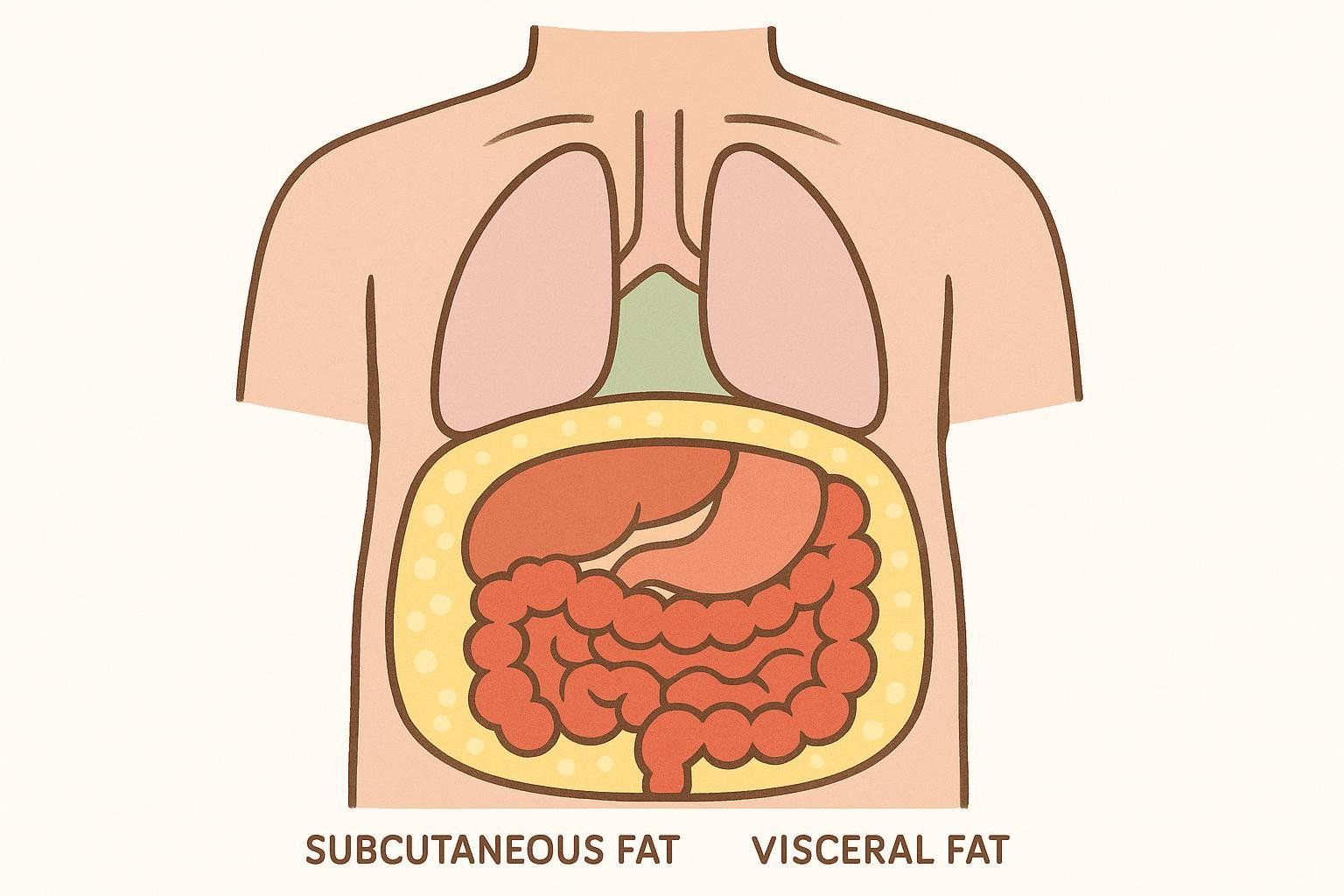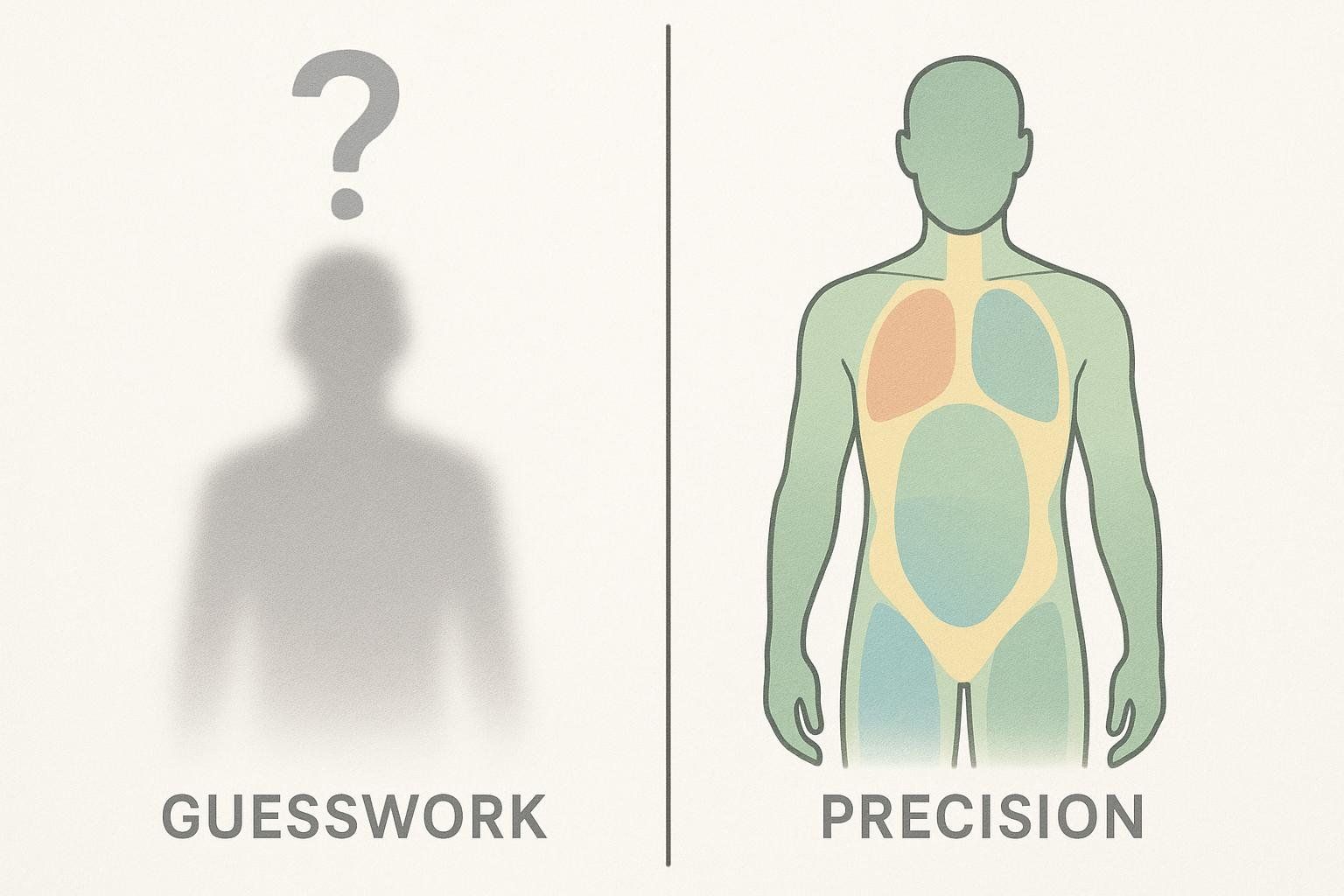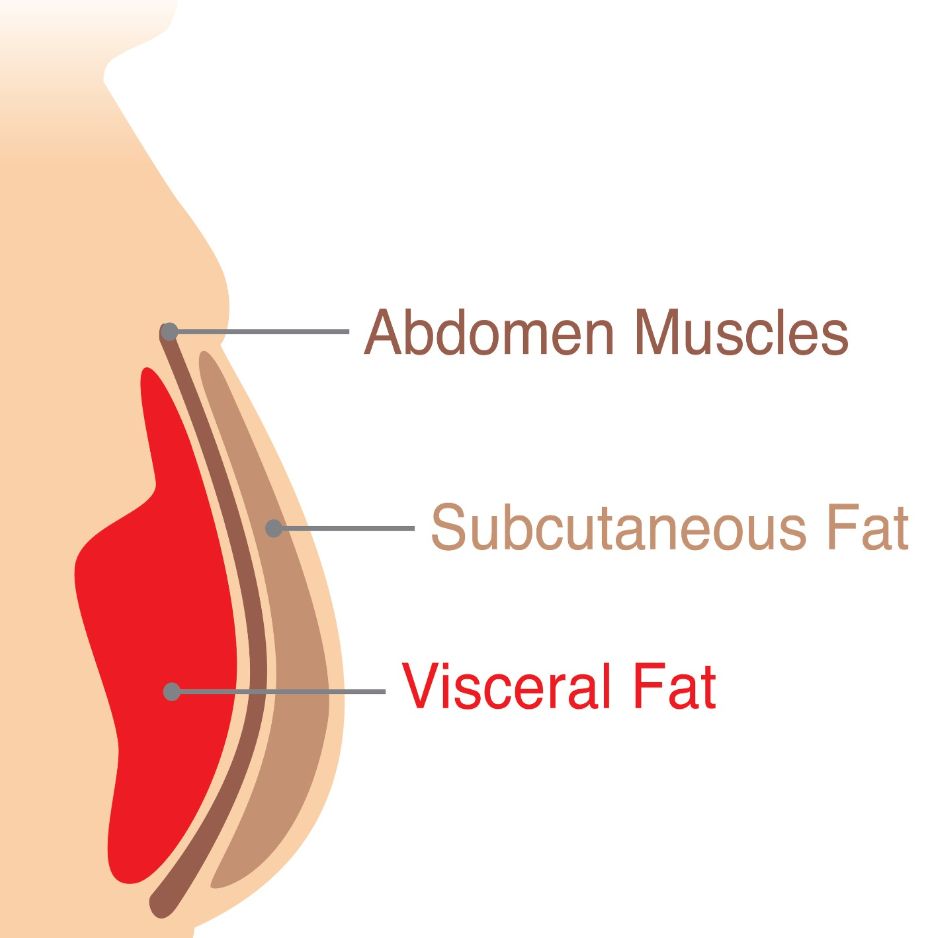What Is My Metabolic Type? The Complete Guide to Ectomorph, Mesomorph & Endomorph

What Is My Metabolic Type? The Complete Guide to Ectomorph, Mesomorph & Endomorph Body Types
Metabolic type refers to a popular classification system that categorizes people into body types (ectomorph, mesomorph, endomorph) based on physical characteristics and supposed metabolic differences. While this approach has gained widespread popularity in fitness circles, it lacks scientific support.
Modern research reveals that metabolism is influenced by individual factors like muscle mass, fat distribution, genetics, and hormones—not broad categories. For accurate metabolic insights, precise body composition measurement through DEXA scanning provides personalized data that actually guides effective nutrition and training decisions.
"What's my metabolic type?" It's one of the most searched health questions online, driving millions to seek answers about whether they're an ectomorph, mesomorph, or endomorph. The promise is enticing: discover your metabolic type, follow a tailored plan, and unlock the secret to effortless weight management and optimal fitness.
But here's the reality check: The popular "metabolic type" classification is pseudoscientific. It lacks solid research to support it. Yet understanding your actual metabolic patterns—through evidence-based measurement and analysis—can genuinely transform your approach to health and fitness.
This guide cuts through the noise to reveal:
- Why the popular ectomorph/mesomorph/endomorph system persists despite scientific skepticism
- The real factors that determine your metabolism and body composition
- How DEXA technology provides the precise, individualized data your metabolism actually needs

How Do I Identify My Metabolic Type?
Most people try to identify their metabolic type through online quizzes or visual assessment based on body shape and eating habits. These methods typically categorize you based on questions like:
- How easily do you gain or lose weight?
- What's your natural body build?
- How do you respond to different foods?
- What's your energy level throughout the day?
The problem: These subjective assessments are unreliable and scientifically unfounded. Your responses can vary based on current diet, training status, stress levels, sleep quality, and dozens of other factors that have nothing to do with an inherent "metabolic type."
A better approach: Instead of guessing your type, focus on measuring the actual factors that influence metabolism: body composition, muscle mass distribution, fat storage patterns, and individual response to nutrition and training interventions.
Understanding the 3 Popular Metabolic Types
If you've searched "metabolic type" recently, you've likely encountered the three-category system that dominates fitness media and wellness websites: ectomorph, mesomorph, and endomorph.
Ectomorph: The "Fast Metabolism" Type
Popular characteristics:
- Naturally lean, narrow frame
- Fast metabolism that burns calories quickly
- Difficulty gaining weight or muscle
- High tolerance for carbohydrates
Common diet recommendations:
- High-carbohydrate intake (45-50% of calories)
- Frequent meals throughout the day
- Calorie surplus for muscle gain
Typical exercise guidance:
- Focus on strength training over cardio
- Limit cardio to preserve calories
- Use longer rest periods between sets
Mesomorph: The "Athletic" Type

Popular characteristics:
- Naturally muscular, athletic build
- Efficient metabolism allowing easy muscle gain/fat loss
- Responds quickly to training
- Well-defined muscle separation
Common diet recommendations:
- Balanced macronutrient approach
- Strategic carb timing around workouts
- Flexible calorie adjustment based on goals
Typical exercise guidance:
- Varied training styles work well
- Mix of strength training and cardio
- Periodized programming for specific goals
Endomorph: The "Slow Metabolism" Type

Popular characteristics:
- Broader build with higher body fat percentage
- Slower metabolism that stores energy efficiently
- Tendency to gain weight easily
- Struggles with fat loss despite consistent effort
Common diet recommendations:
- Lower carbohydrate intake
- Higher protein for satiety
- Controlled calorie deficit for fat loss
Typical exercise guidance:
- Higher training frequency (4-6 sessions per week)
- More cardio for calorie burning
- Circuit training and shorter rest periods
This system has become deeply embedded in fitness culture. Major certification bodies like NASM teach it as a framework for program design.
Why Expanding to 5 Metabolic Types Doesn't Work
Some practitioners expand beyond the basic three-type system to include mixed categories like "Ecto-Mesomorph" (combining fast metabolism with athletic traits) and "Endo-Mesomorph" (blending muscle-building capacity with slower metabolism). These additional categories attempt to address the obvious problem that most people don't fit neatly into just three boxes.
However, adding more categories doesn't solve the fundamental issue: these classifications still lack scientific validity and predictive power. The expansion to five types actually highlights the arbitrary nature of the entire system. If three types aren't sufficient to categorize human metabolism, and five aren't either, what's the logical endpoint? The reality is that metabolism exists on a complex, multi-dimensional spectrum that can't be captured by any categorical system.
Is Metabolic Type Legit?
In short, no. The concept has questionable origins and is not supported by modern scientific research.
The Pseudoscientific Origins
The somatotype system (ectomorph, mesomorph, endomorph) originally comes from psychologist William H. Sheldon's 1940s work linking body types to personality traits—connections that have been thoroughly debunked. While the physical classifications persist in fitness contexts, they lack the predictive power often attributed to them.
The related concept of "metabolic typing" was later developed by dentist William Donald Kelley in the 1960s, who linked dietary choices to the sympathetic and parasympathetic nervous systems. According to Wikipedia, Kelley was convicted of practicing medicine without a license in 1970, and the practice has been labeled as pseudoscientific due to lack of supporting evidence.

What the Research Actually Shows
Modern research paints a different picture. Metabolism is influenced by complex, individualized factors including:
- Genetics (but not in simple categorical ways)
- Age and hormonal status
- Body composition (muscle mass burns more calories than fat)
- Activity level and exercise history
- Nutritional status and health conditions
- Environmental factors
These factors interact in highly individual ways that can't be captured by placing someone into one of three broad categories.
The Problem with Categorical Thinking
This categorical thinking fails because real-world metabolism is far more nuanced:
- Metabolic rate varies significantly between individuals even of the same body weight and composition
- Training history has massive impacts on how your body responds to nutrition and exercise
- Hormonal factors like thyroid function, insulin sensitivity, and sex hormones create unique metabolic patterns
- Body fat distribution matters more than total body fat for health risks and metabolic function
Simply put, trying to fit the complexity of human metabolism into three broad categories is like trying to predict weather patterns by looking at whether it's spring, summer, or fall. The framework is too crude to provide meaningful guidance.
Is There a 'Best' Metabolic Type for Weight Loss?
Asking for the "best" metabolic type for weight loss highlights a common misconception about how metabolism influences weight management. There's no single "type" of metabolism that's inherently better for weight loss. Instead, successful weight loss depends on creating an energy deficit while preserving muscle mass and supporting overall health.
Factors That Actually Support Weight Loss:
Higher Muscle Mass:
- Muscle tissue burns more calories at rest than fat tissue
- Strength training during weight loss helps preserve muscle
- Research shows that maintaining muscle mass during weight loss leads to better metabolic outcomes

Efficient Fat Utilization:
- The ability to burn fat for fuel during exercise and at rest
- Improved through consistent aerobic training and proper nutrition
- Enhanced by managing insulin sensitivity
Metabolic Flexibility:
- The capacity to switch between burning carbs and fats based on availability
- Developed through varied training and balanced nutrition
- Not determined by "metabolic type"
Healthy Hormone Function:
- Adequate thyroid hormones for metabolic rate
- Balanced insulin for blood sugar control
- Proper leptin signaling for appetite regulation
The Real Weight Loss Equation:
Instead of worrying about your "metabolic type," focus on:
- Creating a moderate calorie deficit (300-500 calories below maintenance)
- Preserving muscle mass through resistance training and adequate protein
- Optimizing body composition rather than just losing weight
- Supporting metabolic health through quality nutrition and recovery
What Actually Determines Your Metabolic Patterns
Instead of relying on outdated categorical systems, modern science focuses on measurable, actionable factors that directly influence your metabolism:
Body Composition (Not Just Body Weight)
Your ratio of muscle mass to fat mass is the single strongest predictor of metabolic rate. Muscle tissue is metabolically expensive—it burns calories even at rest. Understanding what body composition is and how it affects your metabolism is crucial because research shows that changes in muscle mass directly correlate with changes in resting metabolic rate.
Why this matters: Two people of identical weight can have dramatically different metabolic rates based on their muscle-to-fat ratio. The person with more muscle will burn significantly more calories throughout the day.
Visceral Fat Distribution
Not all body fat behaves the same way metabolically. Visceral fat (around your organs) is far more metabolically active than subcutaneous fat (under your skin). Understanding what visceral fat is and how it impacts your body is critical because studies show that visceral fat releases inflammatory compounds and hormones that can disrupt normal metabolic function.
Why this matters: Two people with the same body fat percentage can have vastly different health risks and metabolic profiles based on where that fat is stored.

Insulin Sensitivity and Glucose Metabolism
How efficiently your body processes carbohydrates varies dramatically between individuals and changes over time based on diet, exercise, sleep, and stress. Some people maintain excellent insulin sensitivity on higher-carb diets, while others function better with moderate carbohydrate intake.
Why this matters: Your individual response to carbohydrates—not your "type"—should determine your nutritional approach.
Training History and Muscle Fiber Composition
Your exercise background and genetic muscle fiber composition influence how you respond to different types of training and nutrition. Research on muscle fiber types shows that people with more fast-twitch fibers tend to excel at power activities and may benefit from different nutritional strategies than those with predominantly slow-twitch fibers.
Why this matters: Your training should be based on your goals and response patterns, not arbitrary type categories.
The DEXA Advantage: Precision Over Guesswork
While metabolic typing tries to categorize you based on external appearance and subjective questionnaires, DEXA (Dual-Energy X-ray Absorptiometry) scanning provides precise, objective data on the factors that actually determine your metabolic patterns.

What DEXA Reveals That "Types" Cannot
Complete Body Composition Breakdown:
- Exact muscle mass distribution throughout your body
- Precise fat mass and where it's located
- Visceral fat levels (the metabolically dangerous kind)
- Bone density for long-term health monitoring
Regional Analysis:
- Muscle imbalances that affect movement and metabolism
- Fat distribution patterns that influence health risks
- Changes over time to track what's actually working
Metabolic Insights:
- Whether you need to build muscle to boost metabolism
- If visceral fat is creating health risks despite normal weight
- How your body composition compares to others in your age/gender group
Real Data, Real Results
Consider this scenario: Two 35-year-old men, both 175 pounds, both appear to have similar builds. They take a metabolic typing quiz that categorizes them as the same type—"mesomorph." Based on this classification, they'd receive identical training and nutrition recommendations.
But DEXA reveals the full story:
- Person A: 18% body fat, high muscle mass, low visceral fat → Focus on performance nutrition and strength progression
- Person B: 24% body fat, lower muscle mass, elevated visceral fat → Priority on body recomposition and metabolic health markers
They may have the same superficial type, but their underlying physiology is completely different and requires unique strategies. This is why precision matters more than categories.
A Science-Based Approach to Optimizing Your Metabolism
Instead of guessing your "type," here's how to build a personalized approach based on actual data:
Step 1: Get Baseline Measurements
Essential data points:
- DEXA scan for complete body composition
- Resting metabolic rate (RMR) testing if available
- Consulting a healthcare provider for blood work on metabolic markers (e.g., glucose, insulin, lipids)
- Performance baselines (strength, endurance capacity)
Step 2: Identify Your Individual Response Patterns
Track how you respond to:
- Different macronutrient ratios
- Various training intensities and frequencies
- Sleep and stress management strategies
- Meal timing and frequency
Step 3: Optimize Based on Your Data
Build your approach around:
- Your current body composition (not theoretical type)
- Your specific goals (performance, health, aesthetics)
- Your lifestyle constraints (time, preferences, circumstances)
- Your response patterns (what actually works for your body)
Step 4: Monitor and Adjust
Regular tracking through:
- DEXA scans every 3-6 months to track changes
- Performance metrics relevant to your goals
- Biomarkers for metabolic health
- Subjective measures (energy, sleep quality, mood)
The Bottom Line: Your Metabolism Is Unique
The appeal of metabolic typing is understandable—who wouldn't want a simple framework that explains their body's quirks and provides a clear path forward? But your metabolism is far too complex and individual to fit neatly into one of three categories.

Rather than limiting yourself with outdated classification systems, embrace the power of precision measurement. DEXA scanning technology reveals exactly what your body needs: whether you should focus on building muscle, reducing visceral fat, optimizing performance, or all three.
Ready to discover what your metabolism actually needs? Instead of taking another quiz or following generic "type" advice, get the precise data that leads to real results. Book your DEXA scan at a BodySpec location and start building a truly personalized approach to your health and fitness goals.
Your metabolism isn't a type—it's uniquely yours. Treat it that way.


